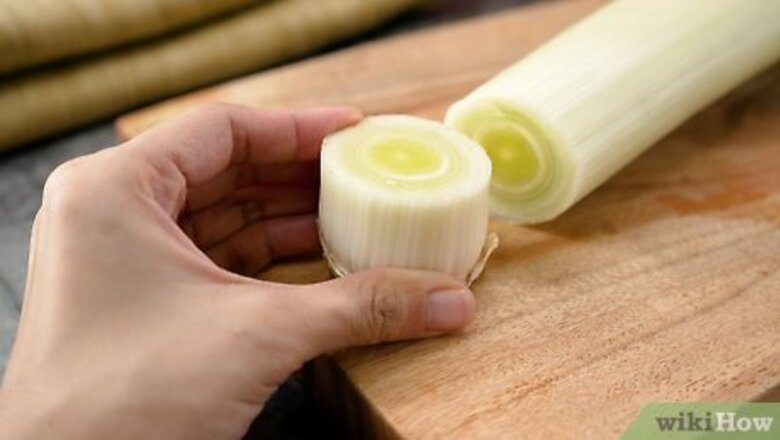
views
Chopping Leeks into Simple Slices
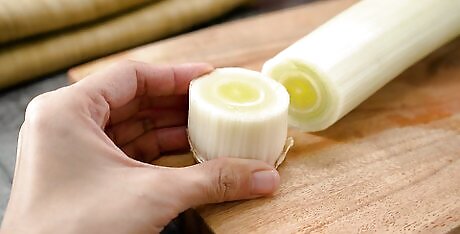
Remove the root and leaves. Place your leek lengthwise on a cutting board, then use a sharp knife to chop off the stringy root. Marrow Private Chefs suggest you "remove the bottom ½”" of the stalk to cut off the correct amount of root. Then, cut off the leaves at the opposite end of the stalk. You'll be left with the part that's white or pale yellow at the center, and pale green at the end where you chopped off the leaves. Leek leaves are very tough, so you can usually discard them after slicing them off, unless you plan to boil them in a broth or stock.
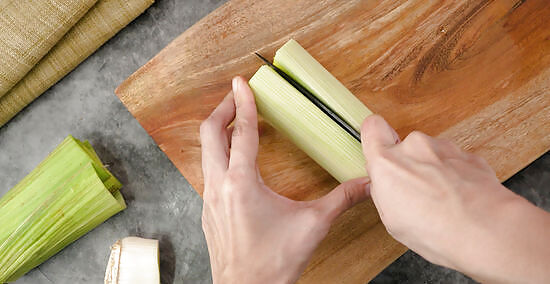
Cut the stalk in half lengthwise. Marrow Private Chefs recommend making the cut "lengthwise from root to tip." Push the tip of your knife into the leek at the top of the stalk. Then, cut down the center, splitting the leek in half. You’ll be left with two leek halves that look like half barrels.
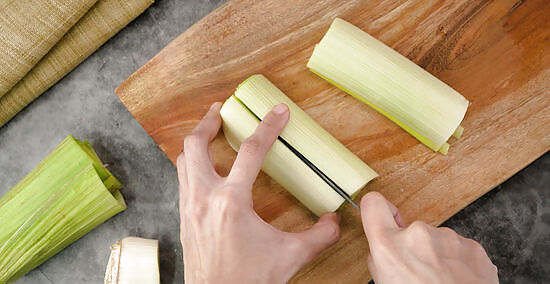
Slice the leek halves in half. Marrow Private Chefs instruct, "take the two halves [from the previous step] and slice [them] lengthwise again, giving you 4 long quarters." Lay both leek halves on their flat sides. Run your knife down the center of each piece lengthwise. Cutting both leek halves this way leaves you with quarters. You can skip this step if you want to cut your leeks into half moons. For half moons, slice your leek halves across the width into ⁄8 inch (0.32 cm) pieces (or even smaller, if desired.)
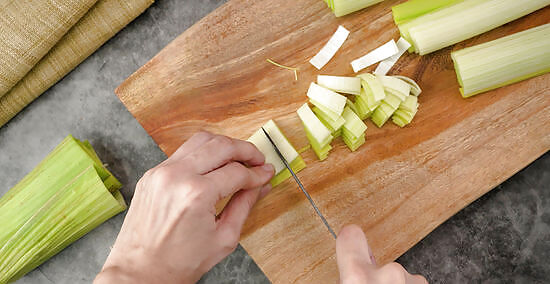
Chop the leek quarters into small pieces. Marrow Private Chefs advises "[slicing] them across in ⁄8 to ⁄4 inch (0.32 to 0.64 cm) strips." Cut across the width of the stalks, depending on how finely you want to chop your leeks. Work from the bottom up, stopping where the pale green part starts if desired. The pale green part of the stalk – the part closest to where you cut the leaves off – may or may not be OK to use, depending on your recipe.
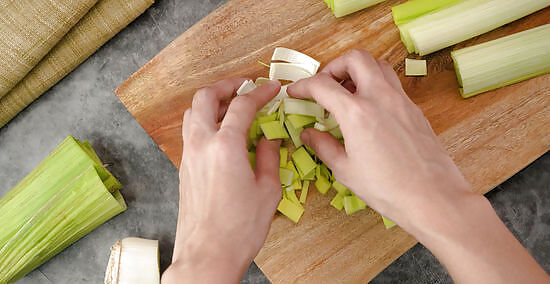
Separate the chopped leeks with your fingers. Use your fingers to pull apart the chopped leek pieces gently. You can also separate the leeks by placing them in a colander or big strainer and tossing them around a bit.
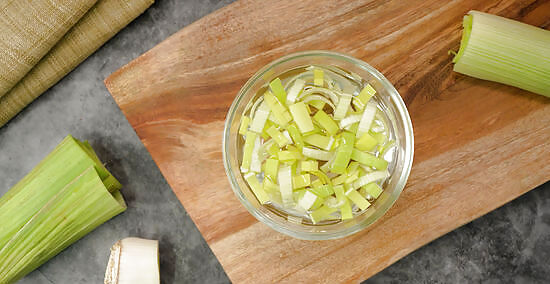
Clean your freshly chopped leeks. Marrow Private Chefs remind cooks: "Don’t forget to rinse thoroughly to remove any dirt from between the leaves!". If your leeks appear to be dirty, you may need to submerge the chopped and separated pieces in a bowl or sink full of clean water. Allow to soak for 10-15 minutes, and any dirt will sink to the bottom of the bowl or the sink Rinse the slices after soaking, then air-dry them or pat them dry with a paper towel. When they’re clean, these leeks will be cut into the perfect shape for sautéeing, boiling, stir-frying, or a multitude of other uses.
Cutting Leeks into a Julienne
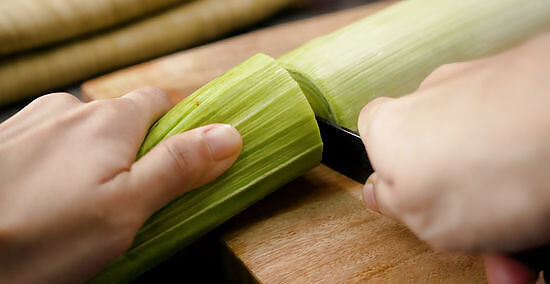
Chop off the stringy root with a sharp knife. According to Marrow Private Chefs, "want to separate the upper leaves (dark green) from the lower stalk (light green)." If you want to use the leaves to flavor soups and roasts, you might want to consider putting them in a resealable bag and freezing them for later instead of throwing them away.
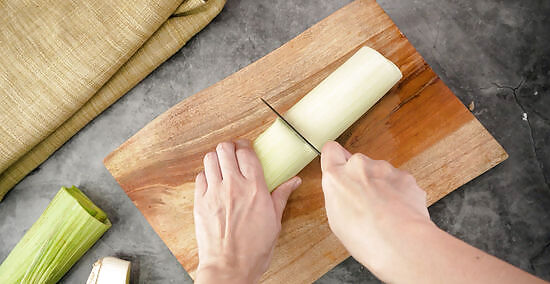
Slice the leek in half across the width. Technically speaking, julienne cuts measure about 3 inches (7.6 cm) long. The average leek stalk measures 5 to 6 inches (13 to 15 cm), so cutting the leek in two will make it easier to julienne. It's OK for a julienne to be longer than 3 inches (7.6 cm). Just follow your recipe or your creative instincts to cut julienne slices that work for your dish.
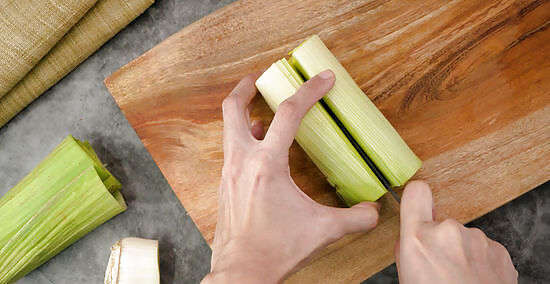
Cut each 3 inches (7.6 cm) piece of leek in half lengthwise. Start by pointing your knife into the stalk. Cut the stalk all the way through and down the middle until it's completely cut in half.

Position the leek halves flat-side down on the cutting board. The rounded side should be upwards, facing you – this will prevent the vegetable from slipping out from under your knife. However, if you have experience handling a sharp knife, you can position the leek on either the flat or rounded side.
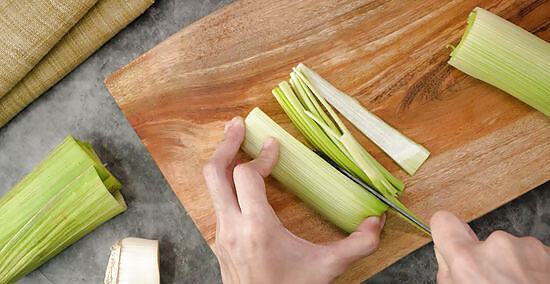
Cut the leek into thin, long slices. Start by positioning your knife at the long edge of the leek. Carefully slice the leek into ⁄8 inch (0.32 cm) lengthwise strips, or wider as desired. Continue making long, lengthwise slices across the width of the leek, from one long edge to the other.
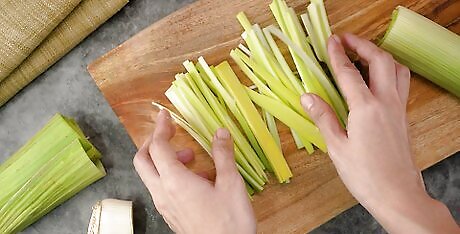
Separate the leek slices as needed. The leeks may come apart without you separating them much, but if some of them are stuck together, gently toss them around with your fingers until they separate.
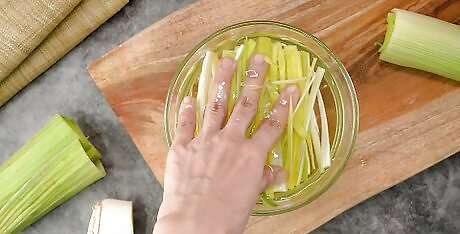
Clean your julienned leeks. If you notice any dirt after slicing your leeks, you may need to submerge the your long, thin slices in a bowl or sink full of clean water. Allow them to soak for 10-15 minutes – any dirt should sink to the bottom of the bowl or the sink. Rinse the slices after soaking, then air-dry them or pat them dry with a paper towel. Now, your thinly cut leeks are ready to be cooked. Try frying them to use as a garnish for meats or other dishes, or including them in a mixed vegetable dish with other julienned veggies.


















Comments
0 comment